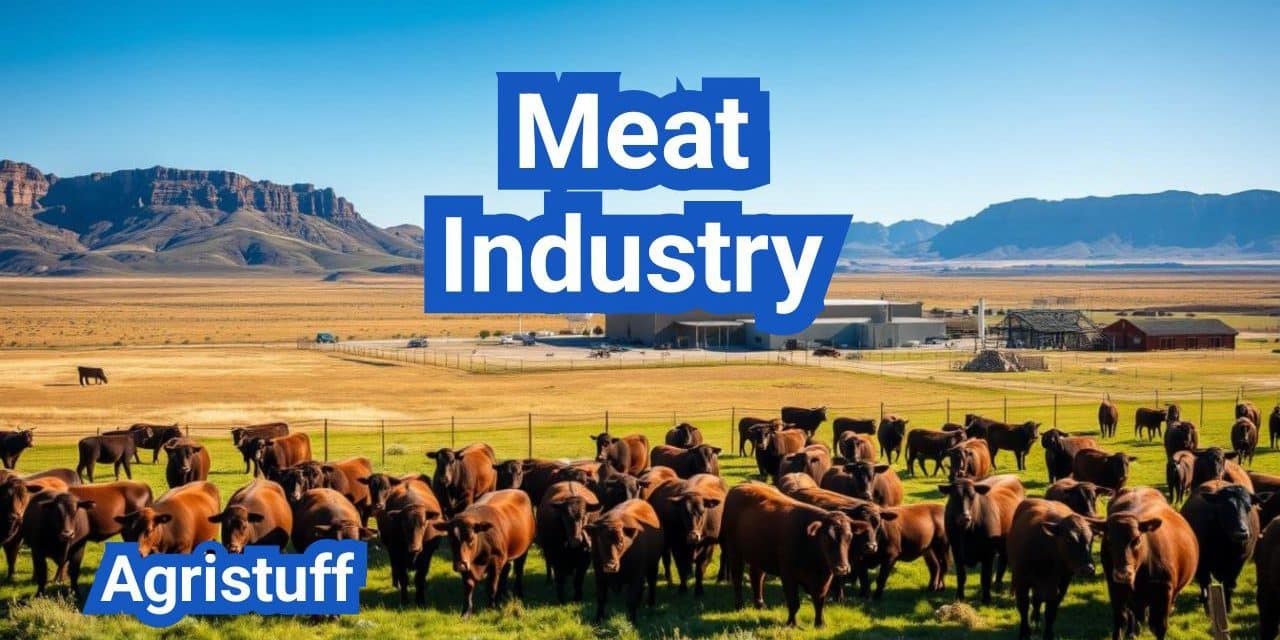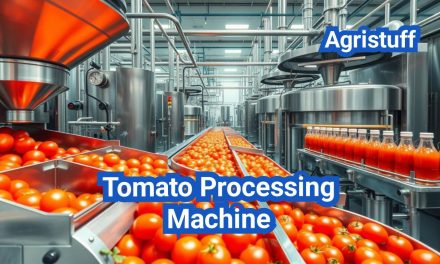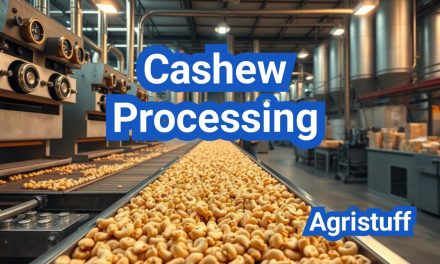The U.S. meat industry is a significant contributor to the country’s agricultural economy, with a complex interplay of factors influencing its dynamics.
The total value of meat production exceeds $100 billion annually, with various segments such as beef, pork, poultry, and lamb, each having unique characteristics and market trends.
Understanding the intricacies of the U.S. market is essential for stakeholders, including producers, processors, and consumers, who are influenced by consumer demand, production costs, and environmental concerns.
Key Takeaways
- The U.S. meat market is shaped by consumer demand and production costs.
- FSIS inspection requirements play a crucial role in ensuring food safety.
- HACCP in meat plants is essential for maintaining high food safety standards.
- Meat labeling regulations impact consumer choices and market trends.
- The Packers and Stockyards Act regulates the industry and protects stakeholders.
Understanding the U.S. Meat Industry Structure
To grasp the U.S. meat industry’s dynamics, it’s essential to examine its structure, major companies, and economic impact. The industry is a complex network of various segments, including beef, pork, poultry, and lamb production.
Key Segments: Beef And Poultry Production
The U.S. meat industry is primarily driven by beef and poultry production. Beef production accounts for approximately 50% of total U.S. meat production, making it a significant segment. Poultry production is another crucial component, with the U.S. being one of the world’s largest producers of chicken.
The beef production segment is characterized by large cattle ranches and feedlots, particularly in states like Texas, Oklahoma, and Nebraska. Poultry production, on the other hand, is more widespread across the country, with major production centers in the Southeast.
Major Companies and Market Concentration
The U.S. meat industry is dominated by a few large companies. Tyson Foods and JBS USA are among the leading players in both beef and poultry production. Market concentration is significant, with the top four companies controlling a substantial share of the market.
| Company | Segment | Market Share (%) |
|---|---|---|
| Tyson Foods | Beef and Poultry | 20 |
| JBS USA | Beef and Poultry | 18 |
| Cargill | Beef | 15 |
Economic Impact and Employment Statistics
The U.S. meat industry has a significant economic impact, contributing billions of dollars to the GDP and employing hundreds of thousands of people. The industry’s economic influence extends beyond production, affecting related sectors such as feed production, transportation, and retail.
Employment statistics indicate that the meat industry is a substantial employer, with jobs ranging from ranching and farming to processing and packaging. The industry’s workforce is distributed across various states, with major processing plants located in rural areas.
Navigating Federal Regulatory Frameworks

Federal regulatory frameworks play a vital role in ensuring the safety and quality of meat products. The U.S. meat industry is subject to a complex set of regulations enforced by various federal agencies, primarily the USDA and FDA.
USDA vs. FDA Jurisdiction and Requirements
The USDA’s Food Safety and Inspection Service (FSIS) is responsible for ensuring the safety of meat, poultry, and egg products. The FDA, on the other hand, regulates other food products, including dairy, seafood, and produce. Understanding the jurisdiction and requirements of both agencies is crucial for meat processing plants to ensure compliance.
The USDA’s FSIS has strict guidelines for the handling, processing, and labeling of meat products. This includes requirements for sanitation, HACCP plans, and labeling accuracy. The FDA also has regulations that impact the meat industry, particularly regarding the use of certain ingredients and additives.
State vs. Federal Inspection Systems
Meat processing plants can be subject to either state or federal inspection systems, depending on their operations and distribution channels. Plants that distribute products across state lines must comply with federal inspection requirements, while those that operate solely within a state may be subject to state inspection systems.
State inspection systems are often equivalent to federal systems but may have additional or different requirements. Understanding the differences between state and federal inspection systems is essential for compliance, especially for plants that operate in multiple states.
Steps for Regulatory Compliance for New Entrants
New entrants into the meat processing industry must take several steps to ensure regulatory compliance. First, they must determine whether they will be subject to state or federal inspection systems. Then, they must develop and implement a HACCP plan, ensure sanitation and labeling compliance, and train staff on regulatory requirements.
Additionally, new entrants should familiarize themselves with the FSIS regulations and guidelines, as well as any relevant FDA requirements. This includes understanding the labeling approval process, proper handling and storage procedures, and requirements for record-keeping.
Complying with FSIS Inspection Requirements
Understanding and adhering to FSIS inspection requirements is essential for maintaining high standards in meat processing. The FSIS (Food Safety and Inspection Service) is responsible for ensuring that the nation’s meat supply is safe, wholesome, and accurately labeled.
Preparing for Ante-mortem and Post-mortem Inspection
Ante-mortem inspection involves examining animals before slaughter to identify any signs of disease or injury. This step is critical in preventing the entry of unsafe products into the food chain.
Key aspects of ante-mortem inspection include:
- Trained personnel observing animals for signs of illness or stress
- Proper record-keeping of animal health and any issues identified
- Segregation of animals that require further examination or are deemed unfit for slaughter
Post-mortem inspection, on the other hand, involves examining the carcass and organs after slaughter to detect any evidence of disease or contamination.
Working with Inspectors Effectively
Building a positive and cooperative relationship with FSIS inspectors is vital for smooth operations. This includes:
- Providing inspectors with necessary facilities and equipment
- Ensuring timely access to required documentation and records
- Addressing any concerns or issues raised by inspectors promptly
Managing Non-compliance Records (NRs)
Non-compliance Records are issued when a facility fails to meet FSIS requirements. Effective management of NRs involves:
| Step | Description |
|---|---|
| 1. Review | Carefully review the NR to understand the nature of the non-compliance |
| 2. Root Cause Analysis | Identify the root cause of the non-compliance to prevent recurrence |
| 3. Corrective Action | Implement corrective actions as required by the FSIS |
| 4. Documentation | Document all actions taken in response to the NR |
By understanding and complying with FSIS inspection requirements, meat processing facilities can ensure a safe and wholesome product, maintain regulatory compliance, and avoid costly non-compliance issues.
Developing and Implementing HACCP in Meat Plants

HACCP, or Hazard Analysis and Critical Control Points, is a systematic approach to identifying and controlling hazards in the meat production process. “HACCP is a preventive approach to food safety, focusing on identifying and controlling hazards before they occur,” as emphasized by food safety experts.
Conducting Hazard Analysis for Different Meat Types
The first step in developing a HACCP plan is conducting a thorough hazard analysis. This involves identifying potential biological, chemical, and physical hazards associated with different types of meat products. For instance, beef products may be susceptible to E. coli contamination, while poultry products may be at risk for Salmonella.
A comprehensive hazard analysis considers the entire production process, from raw material receipt to final product distribution. It is essential to involve a multidisciplinary team in this process to ensure that all potential hazards are identified and assessed.
Establishing Critical Control Points and Limits
Once hazards are identified, the next step is to establish Critical Control Points (CCPs) and their corresponding critical limits. CCPs are points in the process where controls can be applied to prevent or eliminate hazards. For example, cooking is a CCP for many meat products, as it can effectively reduce or eliminate pathogens.
Critical limits are the maximum or minimum values to which a biological, chemical, or physical parameter must be controlled at a CCP to prevent, eliminate, or reduce the hazard to an acceptable level. Establishing these limits requires a thorough understanding of the production process and the hazards involved.
“The key to effective HACCP implementation is not just identifying CCPs, but also establishing and maintaining rigorous monitoring and verification procedures,” notes a leading food safety consultant.
Creating Monitoring and Verification Procedures
Monitoring procedures are essential for ensuring that CCPs are under control. These procedures involve regular observations or measurements to determine whether a CCP is within the established critical limits. Verification procedures, on the other hand, are used to confirm that the HACCP plan is working effectively.
Examples of monitoring procedures include temperature checks during cooking or storage, while verification activities might involve reviewing monitoring records, conducting microbial testing, or performing calibration checks on equipment.
By implementing a robust HACCP plan, meat plants can significantly reduce the risk of foodborne illnesses and ensure compliance with regulatory requirements. Effective HACCP implementation requires ongoing commitment and continuous improvement.
Mastering Meat Labeling Regulations
Understanding and implementing meat labeling regulations effectively is vital for meat producers and processors. Meat labeling regulations are a critical aspect of ensuring compliance in the U.S. meat industry. These regulations not only impact producers and processors but also play a significant role in informing consumers about the products they purchase.
Designing Compliant Product Labels
Designing compliant product labels involves several key elements. First, labels must include accurate and clear information about the product, including its name, ingredients, and any relevant handling or storage instructions. Second, labels must comply with specific formatting requirements, such as font size and style. Finally, labels must include any necessary certifications or claims, such as “USDA Organic” or “Globe-Free.” Ensuring that labels are compliant helps to avoid costly rejections or recalls.
Key Labeling Requirements:
- Product name and description
- Ingredient list
- Handling and storage instructions
- Necessary certifications or claims
Navigating the Label Approval Process
Navigating the label approval process can be complex, but it is a crucial step in ensuring compliance. The process typically involves submitting label designs to the relevant regulatory authority, such as the USDA’s Food Safety and Inspection Service (FSIS). The FSIS reviews the labels to ensure they comply with all relevant regulations. To streamline the process, it is essential to understand the specific requirements and ensure that all necessary information is included.
| Step | Description |
|---|---|
| 1 | Prepare label design |
| 2 | Submit label to FSIS |
| 3 | FSIS reviews label for compliance |
| 4 | Receive approval or revision request |
Making Proper Claims: Organic, Natural, and Antibiotic-Free
Making proper claims on meat labels is critical. Claims such as “organic,” “natural,” and “antibiotic-free” must be supported by evidence and comply with specific regulations. For example, to label a product as “organic,” it must be produced without the use of synthetic fertilizers, pesticides, or genetically modified organisms (GMOs). Understanding the requirements for these claims and ensuring that they are used accurately is vital for maintaining consumer trust and avoiding regulatory issues.
Example of Proper Claims:
- Organic: Produced without synthetic fertilizers, pesticides, or GMOs
- Natural: No artificial ingredients or added colors
- Antibiotic-Free: Raised without antibiotics
By mastering meat labeling regulations, producers and processors can ensure compliance, build consumer trust, and maintain a competitive edge in the market.
Operating Under the Packers and Stockyards Act

The Packers and Stockyards Act is a crucial regulation for the U.S. meat industry, governing the business practices of meatpackers, live poultry dealers, and swine production contracts. This act ensures fair competition and protects the rights of livestock producers and poultry growers.
Understanding Livestock Procurement Requirements
Livestock procurement under the Packers and Stockyards Act involves several key requirements. Packers must provide fair and transparent pricing for livestock purchases. This includes:
- Clearly stating the terms of purchase
- Providing accurate scales and weighing procedures
- Maintaining records of livestock purchases
These requirements help prevent unfair practices that could disadvantage livestock producers.
Maintaining Proper Payment Records
Maintaining accurate and detailed payment records is essential for compliance with the Packers and Stockyards Act. This includes:
- Recording the weight and price of livestock purchased
- Documenting any deductions or adjustments made to the purchase price
- Retaining records for a specified period
Proper payment records help ensure that livestock producers receive fair compensation for their livestock.
Avoiding Unfair Practices and Penalties
To avoid penalties under the Packers and Stockyards Act, meatpackers and live poultry dealers must refrain from engaging in unfair or deceptive practices. Common violations include:
- Failing to pay for livestock in a timely manner
- Using deceptive pricing practices
- Discriminating against certain producers
By understanding and complying with the Packers and Stockyards Act, businesses can avoid costly penalties and maintain a positive reputation within the industry.
Optimizing U.S. Beef Production Processes
The U.S. beef industry’s success hinges on optimizing production processes. Efficient production is crucial for maintaining competitiveness in both domestic and international markets. This involves a comprehensive approach that includes effective cattle management, streamlined slaughter and fabrication processes, and maximizing value through proper grading and yield.
Cattle Management and Procurement Strategies
Effective cattle management is the foundation of successful beef production. This includes implementing robust procurement strategies that ensure a consistent supply of high-quality cattle. Producers must balance factors such as cattle health, genetics, and feed quality to optimize production.
Procurement strategies may involve forming alliances with cattle suppliers, investing in cattle breeding programs, and utilizing data analytics to predict market trends. By adopting these strategies, producers can reduce costs and improve the overall efficiency of their operations.
Implementing Efficient Slaughter and Fabrication
Efficient slaughter and fabrication processes are critical for maximizing the value of beef products. This involves investing in modern slaughterhouse equipment and training staff to handle cattle humanely and efficiently.
Streamlining fabrication processes can also help reduce waste and improve product quality. Implementing cutting-edge technologies, such as automated carcass grading systems, can enhance accuracy and consistency in beef production.
Maximizing Value Through Proper Grading and Yield
Proper grading and yield assessment are essential for maximizing the value of beef products. The USDA’s beef grading system provides a standardized framework for evaluating carcass quality and yield.
By understanding and applying these grading standards, producers can optimize their production to meet market demands. This includes focusing on factors such as marbling, maturity, and carcass weight to achieve higher grades and better yields.
Managing Poultry Processing Lines Effectively
Managing poultry processing lines effectively is a complex task that involves configuring line speeds, implementing modern inspection systems, and ensuring worker safety. Poultry processing lines are critical to the chicken manufacturing industry, requiring precise management to maintain compliance and efficiency.
Configuring Line Speeds for Compliance and Efficiency
Configuring line speeds is a delicate balance between maximizing production efficiency and ensuring compliance with regulatory requirements. Chicken manufacturers must optimize their line speeds to meet demand without compromising on safety or quality.
The modernized poultry inspection system allows for more flexible line speeds, but this flexibility comes with the responsibility of ensuring that the increased speed does not compromise food safety or worker safety.
| Line Speed (birds per minute) | Compliance Requirements | Efficiency Impact |
|---|---|---|
| 140 | Regular inspection, strict sanitation | High production capacity |
| 175 | Enhanced inspection, additional sanitation measures | Very high production capacity |
Implementing the Modernized Poultry Inspection System
The modernized poultry inspection system represents a significant shift in how poultry processing is regulated. By focusing on risk-based inspection and prevention-based controls, this system aims to improve food safety while giving establishments more flexibility in their operations.
To implement this system effectively, chicken manufacturers must conduct thorough risk assessments and establish robust controls to mitigate identified risks.
Addressing Worker Safety and Ergonomics
Worker safety and ergonomics are critical considerations in poultry processing. The fast-paced and physically demanding environment of a poultry processing plant can pose significant risks to workers, including musculoskeletal injuries and other health issues.
To address these challenges, chicken manufacturers should implement ergonomic workstation designs, provide regular training on safe work practices, and invest in technologies that reduce the physical strain on workers.
Meeting Food Safety Performance Standards

Meeting food safety performance standards requires a multifaceted approach in the meat industry. This involves understanding and implementing various strategies to ensure the production of safe and wholesome products.
One of the critical aspects of meeting these standards is the implementation of effective pathogen reduction strategies. This includes practices such as proper sanitation, effective cooking procedures, and the use of antimicrobial interventions to minimize the risk of contamination.
Implementing Pathogen Reduction Strategies
Pathogen reduction strategies are designed to minimize the presence of harmful pathogens in meat products. This can be achieved through various methods, including:
- Sanitation and cleaning protocols
- Antimicrobial treatments
- Proper handling and storage practices
Establishing Effective Testing Programs
An effective testing program is crucial for verifying the safety of meat products. This involves regular sampling and testing for pathogens, as well as maintaining detailed records of test results.
Testing programs should be designed to detect potential contamination early, allowing for swift corrective action to be taken. This not only ensures compliance with food safety regulations but also protects consumer health.
Developing Food Safety Incident Response Plans
Despite best efforts, food safety incidents can still occur. Therefore, it is essential to have a food safety incident response plan in place. This plan should outline the procedures to be followed in the event of a contamination incident, including containment, investigation, and corrective actions.
A well-developed response plan enables meat processing facilities to respond quickly and effectively to incidents, minimizing the risk to consumers and reducing the potential for costly recalls.
Selecting and Maintaining Meat Processing Equipment

The effectiveness of meat processing operations is significantly influenced by the choice and upkeep of processing equipment. Ensuring that the equipment is well-suited to the specific needs of the operation is crucial for maintaining efficiency and compliance with regulatory standards.
Essential Equipment for Different Processing Operations
Different stages of meat processing require specialized equipment. For instance, industrial meat slicers are essential for precision cutting, while grinders and mixers are necessary for processing ground meats. Understanding the specific requirements of each processing operation helps in selecting the right equipment.
The selection process involves considering factors such as the type of meat being processed, the volume of production, and the desired end product. For example, a facility focused on poultry might prioritize equipment designed for high-speed processing, whereas a facility processing specialty meats might focus on equipment that offers flexibility and precision.
| Processing Operation | Essential Equipment | Key Features |
|---|---|---|
| Slicing | Industrial Meat Slicer | Precision cutting, adjustable thickness |
| Grinding | Meat Grinder | Variable grind settings, easy cleaning |
| Mixing | Meat Mixer | Uniform mixing, sanitation design |
Evaluating Automation and Technology Investments
Investing in automation and advanced technology can significantly enhance the efficiency and consistency of meat processing operations. Automation can help reduce labor costs, improve product quality, and increase throughput. When evaluating potential investments, it’s essential to consider the return on investment (ROI) and how the technology aligns with the facility’s operational needs.
Automation technologies, such as robotic cutting systems and automated packaging lines, can streamline processes and reduce the risk of human error. However, the initial investment and ongoing maintenance costs must be carefully considered.
Implementing Sanitation Standard Operating Procedures
Maintaining a clean and sanitary environment is critical in meat processing facilities. Implementing Sanitation Standard Operating Procedures (SSOPs) helps ensure compliance with food safety regulations and prevents contamination. SSOPs should cover all aspects of the facility, including equipment, utensils, and employee hygiene practices.
Regular cleaning and sanitizing of equipment, along with proper training for employees, are key components of effective SSOPs. This not only helps in maintaining regulatory compliance but also enhances the overall quality and safety of the products.
Accessing and Expanding Meat Export Markets

To stay competitive, U.S. meat producers must navigate the complexities of accessing and expanding meat export markets. The global demand for high-quality meat products is on the rise, driven by increasing consumer purchasing power and changing dietary preferences in emerging markets.
Meeting Country-Specific Export Requirements
One of the primary challenges in accessing meat export markets is complying with country-specific export requirements. Different countries have varying regulations regarding meat production, processing, and packaging. For instance, some countries may require specific certifications or labeling, while others may have strict sanitary and phytosanitary measures.
To successfully export meat products, producers must:
- Research the import regulations of the target country
- Ensure compliance with labeling and packaging requirements
- Obtain necessary certifications and documentation
Obtaining Export Certificates and Documentation
Export certificates and documentation are critical for accessing international markets. The United States Department of Agriculture (USDA) issues various certificates, such as the Export Certificate for Animal Products, which verifies that the products meet the importing country’s requirements.
| Certificate Type | Description | Issuing Authority |
|---|---|---|
| Export Certificate for Animal Products | Verifies compliance with importing country’s regulations | USDA |
| Health Certificate | Confirms the product’s health and safety status | USDA/FSIS |
Developing International Market Relationships
Building strong international market relationships is essential for long-term success in meat export markets. This involves establishing communication channels with potential buyers, understanding their needs, and adapting products and services accordingly.
Strategies for developing international market relationships include:
- Participating in international trade shows and exhibitions
- Engaging in market research to understand consumer preferences
- Establishing partnerships with local distributors or importers
By understanding and complying with country-specific export requirements, obtaining necessary export certificates, and fostering international market relationships, U.S. meat producers can effectively access and expand into meat export markets, capitalizing on the growing global demand for high-quality meat products.
Addressing Environmental Compliance in the Meat Industry

As the U.S. meat industry continues to evolve, addressing environmental compliance has become a top priority for companies seeking to minimize their ecological footprint. Environmental compliance encompasses various aspects, including wastewater treatment systems, air emissions management, and sustainability initiatives.
Wastewater Treatment Systems
Implementing effective wastewater treatment systems is crucial for meat processing plants to manage their environmental impact. These systems help remove contaminants and pollutants from wastewater, ensuring compliance with regulatory standards.
The process involves several stages, including physical, chemical, and biological treatments. Advanced technologies, such as membrane bioreactors and anaerobic digestion, are being adopted to enhance treatment efficiency and reduce energy consumption.
Managing Air Emissions and Odor Control
Managing air emissions and controlling odors are critical components of environmental compliance in the meat industry. Facilities must implement strategies to minimize the release of volatile organic compounds (VOCs) and other pollutants.
Techniques such as biofiltration, scrubbers, and carbon adsorption are employed to reduce air emissions. Additionally, implementing good management practices, such as maintaining equipment and controlling dust, can help mitigate odor issues.
Developing Sustainability Initiatives and Reporting
Sustainability initiatives are becoming increasingly important in the meat industry, with companies recognizing the need to balance economic viability with environmental stewardship. Developing comprehensive sustainability reports helps companies communicate their environmental performance and progress towards their sustainability goals.
These reports typically cover aspects such as energy consumption, water usage, waste management, and greenhouse gas emissions. By transparently reporting their sustainability performance, companies can build trust with stakeholders and demonstrate their commitment to environmental responsibility.
Managing Meat Prices and Market Volatility

The impact of market volatility on meat prices necessitates a comprehensive management strategy. The meat industry is particularly susceptible to fluctuations in supply and demand, which can be exacerbated by factors such as global warming and changes in consumer preferences.
Analyzing Supply Chain Cost Factors is crucial in understanding how meat prices are determined. Supply chain costs include expenses related to livestock procurement, feed, labor, and transportation. By analyzing these factors, producers can identify areas where costs can be optimized without compromising the quality of the meat.
Supply Chain Cost Factors
Several key factors contribute to the overall cost of meat production. These include:
- Livestock procurement costs
- Feed prices
- Labor costs
- Transportation expenses
- Processing and packaging costs
Understanding these cost factors is essential for developing effective pricing strategies. Producers must balance the need to maintain profitability with the pressure to keep prices competitive in a volatile market.
Implementing Pricing Strategies During Inflation
During periods of inflation, implementing the right pricing strategies is critical. Producers can consider strategies such as:
- Price indexing to account for inflation
- Contract pricing to secure stable revenue streams
- Value-based pricing to reflect the quality and uniqueness of their products
Utilizing Futures Markets and Contracting can also help manage price volatility. By locking in prices for future deliveries, producers can hedge against potential price drops, ensuring a more stable revenue stream.
Utilizing Futures Markets and Contracting
Futures markets provide a platform for producers to manage price risk. By entering into futures contracts, producers can secure prices for their products in advance, reducing the impact of price volatility. Contracting with buyers can also provide stability, as it ensures a committed market for the producer’s products.
In conclusion, managing meat prices and market volatility requires a multi-faceted approach that includes analyzing supply chain cost factors, implementing effective pricing strategies, and utilizing futures markets and contracting. By adopting these strategies, producers can better navigate the challenges posed by a volatile market and maintain a competitive edge.
Competing in a Consolidated Meat Industry
As the meat industry consolidates, smaller producers must find innovative ways to remain competitive. The trend towards consolidation is driven by various factors, including economies of scale and the need for greater efficiency. To compete effectively, producers are turning to niche market strategies and direct-to-consumer channels.
Developing Niche Market Strategies
Niche market strategies involve identifying and catering to specific consumer preferences that are not being met by larger producers. This could include producing specialty meats, such as organic or grass-fed beef, or focusing on particular ethnic or cultural markets.
By targeting these niches, smaller producers can command higher prices and build loyal customer bases. Effective niche marketing requires a deep understanding of consumer trends and preferences, as well as the ability to differentiate products from those of larger competitors.
Building Direct-to-Consumer Channels
Direct-to-consumer channels allow producers to bypass traditional distribution networks and sell their products directly to consumers. This can be achieved through various means, including online sales platforms, farmers’ markets, and on-farm sales.
By building direct relationships with consumers, producers can gain valuable insights into consumer preferences and increase their profit margins. Additionally, direct-to-consumer sales can help to build brand loyalty and promote repeat business.
Forming Strategic Alliances and Cooperatives
Another key strategy for competing in a consolidated meat industry is to form strategic alliances and cooperatives. By collaborating with other producers, processors, and distributors, smaller operators can achieve economies of scale and improve their bargaining power.
Cooperatives, in particular, can provide a range of benefits, including shared resources, expertise, and risk. By working together, producers can also improve their ability to innovate and respond to changing market conditions.
Adapting to Future Trends in the U.S. Meat Industry
The U.S. meat industry is on the cusp of significant change, driven by evolving consumer preferences, technological advancements, and shifting regulatory landscapes. As the industry continues to strive for the safest meat supply, understanding these future trends is essential for stakeholders to remain competitive.
Advancements in production of meat are expected to play a crucial role in shaping the future of the U.S. meat industry. With a focus on sustainability, animal welfare, and food safety, the industry is poised to adopt new technologies and practices that enhance the overall quality of meat products.
As the industry adapts to these changes, it is crucial for stakeholders to stay informed about the latest developments in the U.S. meat industry. By doing so, they can navigate the complex regulatory environment, capitalize on emerging opportunities, and contribute to the continued growth and success of the industry.
FAQ
What is the total value of meat production in the U.S.?
The total value of meat production in the U.S. exceeds $100 billion annually.
What are the key segments of the U.S. meat industry?
The key segments of the U.S. meat industry include beef, pork, poultry, and lamb.
What is the role of the USDA in regulating the meat industry?
The USDA is responsible for ensuring the safety and wholesomeness of meat products, and it regulates the industry through various programs, including inspection and labeling requirements.
What is HACCP, and how is it implemented in meat plants?
HACCP (Hazard Analysis and Critical Control Points) is a systematic approach to identifying and controlling hazards in the food production process. It is implemented in meat plants through a series of steps, including hazard analysis, establishing critical control points, and creating monitoring and verification procedures.
What are the requirements for meat labeling regulations?
Meat labeling regulations require accurate and compliant labeling, including proper claims such as “organic,” “natural,” and “antibiotic-free.” Labels must be approved through the USDA’s label approval process.
What is the Packers and Stockyards Act, and how does it regulate the meat industry?
The Packers and Stockyards Act is a federal law that regulates the meat industry by requiring fair business practices, including proper payment records and livestock procurement requirements.
How can meat processors optimize their production processes?
Meat processors can optimize their production processes by implementing efficient slaughter and fabrication, maximizing value through proper grading and yield, and utilizing technology and automation.
What are the key factors in managing poultry processing lines effectively?
Key factors in managing poultry processing lines effectively include configuring line speeds for compliance and efficiency, implementing the Modernized Poultry Inspection System, and addressing worker safety and ergonomics.
How can meat processors meet food safety performance standards?
Meat processors can meet food safety performance standards by implementing pathogen reduction strategies, establishing effective testing programs, and developing food safety incident response plans.
What are the essential equipment for different meat processing operations?
Essential equipment for different meat processing operations include industrial meat grinders, slicers, and packaging machines, as well as sanitation equipment and wastewater treatment systems.
How can meat processors access and expand meat export markets?
Meat processors can access and expand meat export markets by meeting country-specific export requirements, obtaining export certificates and documentation, and developing international market relationships.
What are the key factors in addressing environmental compliance in the meat industry?
Key factors in addressing environmental compliance in the meat industry include implementing wastewater treatment systems, managing air emissions and odor control, and developing sustainability initiatives and reporting.
How can meat processors manage meat prices and market volatility?
Meat processors can manage meat prices and market volatility by analyzing supply chain cost factors, implementing pricing strategies during inflation, and utilizing futures markets and contracting.
What are the strategies for competing in a consolidated meat industry?
Strategies for competing in a consolidated meat industry include developing niche market strategies, building direct-to-consumer channels, and forming strategic alliances and cooperatives.
Conclusion of: Meat Industry in the U.S.
Why the meat industry matters to the U.S. economy and dinner table
The meat industry in the United States touches farms, plants, trucks, grocery aisles, restaurants, and—ultimately—family meals. It is tightly regulated for safety and labeling, capital-intensive in its throughput, and deeply shaped by consumer demand and prices. Understanding how the meat industry is governed, how much it produces, and what shoppers want helps processors, suppliers, and retailers make better operational and strategic decisions. About FSIS
Who regulates the meat industry: FSIS’s core mission
Within the meat industry, the lead federal regulator is USDA’s Food Safety and Inspection Service (FSIS), which provides continuous inspection at slaughter and daily inspection at processing establishments to ensure meat and poultry products are safe, wholesome, and properly labeled. That day-to-day oversight anchors the meat industry’s food safety system and public trust. FSIS mission
How FDA fits alongside USDA in the meat industry
The meat industry often intersects with the U.S. Food and Drug Administration (FDA), which regulates most other foods, seafood, and many shared issues like allergens and certain labeling concerns. FDA and FSIS coordinate on jurisdictional lines and emerging issues, which matters for companies in the meat industry that also handle multi-category foods. FDA food oversight
State programs, CIS, and custom-exempt in the meat industry
Beyond federal inspection, the meat industry includes state Meat and Poultry Inspection (MPI) programs operating under “at least equal to” standards. Some state plants participate in the Cooperative Interstate Shipment (CIS) program to ship across state lines, while custom-exempt facilities process livestock for an owner’s personal use under specific rules. Knowing these pathways expands options for small and mid-sized players in the meat industry. State & CIS overview
HACCP: the preventive backbone of the meat industry
Every federally inspected establishment in the meat industry must maintain Sanitation Standard Operating Procedures (SSOPs) and a Hazard Analysis and Critical Control Point (HACCP) plan that proactively controls hazards—from biological to chemical to physical. These written, validated systems are the core of modern food safety in the meat industry. Federal inspection requirements
Humane handling and the meat industry’s legal duty
The Humane Methods of Slaughter Act and FSIS regulations require humane handling and slaughter of livestock. Compliance is not only an ethical obligation but a regulatory requirement that directly affects the meat industry’s operations, training, and plant design. Humane handling overview
Labeling in the meat industry, including the “Product of USA” rule
Label approval and claims (e.g., ingredients, allergens, nutrition, and origin) are central to the meat industry. In 2024, FSIS finalized the “Product of USA” rule to ensure the claim is truthful and not misleading—impacting packaging and marketing across the meat industry. “Product of USA” final rule
Fair competition and the Packers & Stockyards Act in the meat industry
The Packers & Stockyards Act, enforced by USDA’s Agricultural Marketing Service, seeks to protect fair trade, competition, and payment in livestock and meat industry markets. Recent rulemaking around dealer trusts and related procedures strengthens payment protections for sellers in the meat industry. P&S Act regulations
Imports, reinspection, and border controls for the meat industry
Imported meat products are only eligible from countries with systems FSIS deems equivalent. Once shipped, FSIS conducts reinspection at official import establishments before products can enter U.S. commerce—an important control point for the meat industry’s global supply chains. FSIS import reinspection
Recalls: the meat industry’s playbook for swift action
When issues arise, the meat industry operates under FSIS recall classifications (Class I, II, III) and must maintain written recall procedures. Rapid traceability and communication reduce risk to consumers and economic damage to brands in the meat industry. 9 CFR Part 418 (Recalls)
Throughput snapshot: slaughter volumes and plant footprint in the meat industry
USDA’s annual Livestock Slaughter report shows the meat industry’s federal plant footprint and volumes. In 2024 there were 1,089 federally inspected livestock plants; the largest 12 handled 51% of cattle slaughter, underscoring concentration and scale in parts of the meat industry. NASS Livestock Slaughter 2024
Birds by the billions: poultry throughput in the meat industry
Poultry plants are key to the meat industry’s total protein output. The 2024 Poultry Slaughter Annual Summary details broiler, turkey, and other fowl volumes, offering processors and suppliers insight into seasonal patterns and capacity use in the meat industry. NASS Poultry Slaughter 2024
Livestock supplies and the meat industry’s 2025 beef outlook
Cattle supplies shape beef throughput in the meat industry. As of January 1, 2025, the U.S. herd stood at 86.7 million head (down 1% year-over-year), a constraint that ERS incorporated into its 2025 production outlook—important context for beef packers and retailers across the meat industry. NASS Cattle inventory (Jan 31, 2025)
Production forecasts that guide the meat industry’s plans
ERS’s monthly Livestock, Dairy, and Poultry Outlook adjusts forecasts as conditions change—informing pricing, procurement, and scheduling in the meat industry. Summer 2025 reports lowered beef production forecasts amid tight feeder supplies and policy headwinds affecting trade flows. ERS Outlook (Aug 2025)
Worker safety, line performance, and costs in the meat industry
People keep the meat industry moving, and injury prevention is vital. BLS reports track recordable case rates in animal slaughtering and processing (NAICS 3116), offering benchmarking for safety programs that also protect throughput in the meat industry. BLS industry injury rates (2023)
Inspection coverage and overtime scheduling in the meat industry
Because inspection must cover operations, scheduling and overtime rules influence when and how the meat industry runs lines. FSIS provides inspection at no cost during approved hours, while overtime and holiday coverage are reimbursable—an operational detail with budget impact in the meat industry. FSIS overtime directive
Environmental compliance and water management in the meat industry
Wastewater and byproducts management remain material issues for the meat industry. EPA’s Meat and Poultry Products Effluent Guidelines (40 CFR Part 432) set technology-based limits that plants must meet—requirements that can steer capital spending and sustainability projects in the meat industry. EPA MPP effluent guidelines
Consumer demand: per-capita availability and meat industry momentum
ERS’s Food Price Outlook and food availability data help quantify demand for the meat industry. Recent projections show modest shifts among proteins and price-sensitive substitutions, information processors use to calibrate product mix and pack sizes in the meat industry. ERS Food Price Outlook
Prices, inflation, and what shoppers feel in the meat industry
Price levels at retail influence basket choices and category mix across the meat industry. ERS’s monthly outlook synthesizes CPI and wholesale signals that affect beef, pork, and poultry pricing—knowledge that guides promotions and contracting across the meat industry. ERS price summary
How shoppers choose: insights that shape the meat industry
Preferences for convenience, value, and quality cues (like marbling and grades) shape category performance in the meat industry. Industry research such as FMI’s Power of Meat 2025 highlights meal planning, private label, and health framing trends that steer innovation across the meat industry. FMI Power of Meat
Grading and quality signals consumers recognize in the meat industry
USDA grades (e.g., Prime, Choice, Select) communicate expected eating quality and influence merchandising in the meat industry. Clear labeling and education help shoppers trade up (or down) confidently, aligning supply with demand in the meat industry. USDA on beef grades
Food safety outcomes and the meat industry’s accountability
Pathogens such as Salmonella and Shiga toxin–producing E. coli remain priorities for the meat industry. CDC’s FoodNet tracking informs risk assessments and FSIS policy, underscoring why verification testing and process control matter across the meat industry. CDC FoodNet
Trade flows that expand demand for the meat industry
Exports add value and stabilize carcass utilization in the meat industry. USDA’s April 2025 Livestock and Poultry: World Markets and Trade outlines expected gains for chicken and competitive dynamics in beef, which ripple back to U.S. cutout values and plant schedules in the meat industry. USDA FAS WMT (Apr 2025)
Residues, performance standards, and verification in the meat industry
Residue monitoring and pathogen performance standards are non-negotiables for the meat industry. FSIS’s National Residue Program and Salmonella verification programs support data-driven oversight, keeping the meat industry aligned with public-health goals. FSIS residue data
Practical compliance: Salmonella categories and the meat industry’s continuous improvement
FSIS uses a moving-window approach to categorize establishments’ Salmonella performance, prompting corrective actions and best-practice sharing across the meat industry. Keeping category status strong reduces recall risk and protects brand equity in the meat industry. Performance standards & framework history
Final thought
The U.S. meat industry succeeds when safety systems are preventive, throughput is resilient, and consumer value is clear. By pairing rigorous compliance with smart operations and clear labeling, the meat industry can navigate tight livestock supplies, price swings, and evolving shopper expectations while defending public health and brand trust. FSIS homepage
Sources & References
Below are authoritative references used throughout this article to support facts and best practices in the meat industry.
- USDA FSIS – About FSIS
- FDA – Food Program
- FSIS – State Inspection & CIS
- 9 CFR 303.1 – Custom Exemptions
- FSIS – Federal Inspection Requirements (SSOP/HACCP)
- ECFR – Packers & Stockyards Regulations
- FSIS Directive 9900.2 – Import Reinspection
- 9 CFR Part 418 – Recalls
- USDA NASS – Cattle Inventory (Jan 31, 2025)
- USDA ERS – Livestock, Dairy & Poultry Outlook (Aug 2025)
- BLS – Employer-Reported Workplace Injuries (NAICS 3116)
- FSIS Directive 12800.1 – Overtime/Holiday Inspection Coverage
- EPA – Meat & Poultry Products Effluent Guidelines (40 CFR 432)
- USDA – Beef Grades Explained
- CDC – FoodNet
- USDA FAS – World Markets & Trade (Apr 2025)
- Federal Register – Salmonella Performance Standards (context)










